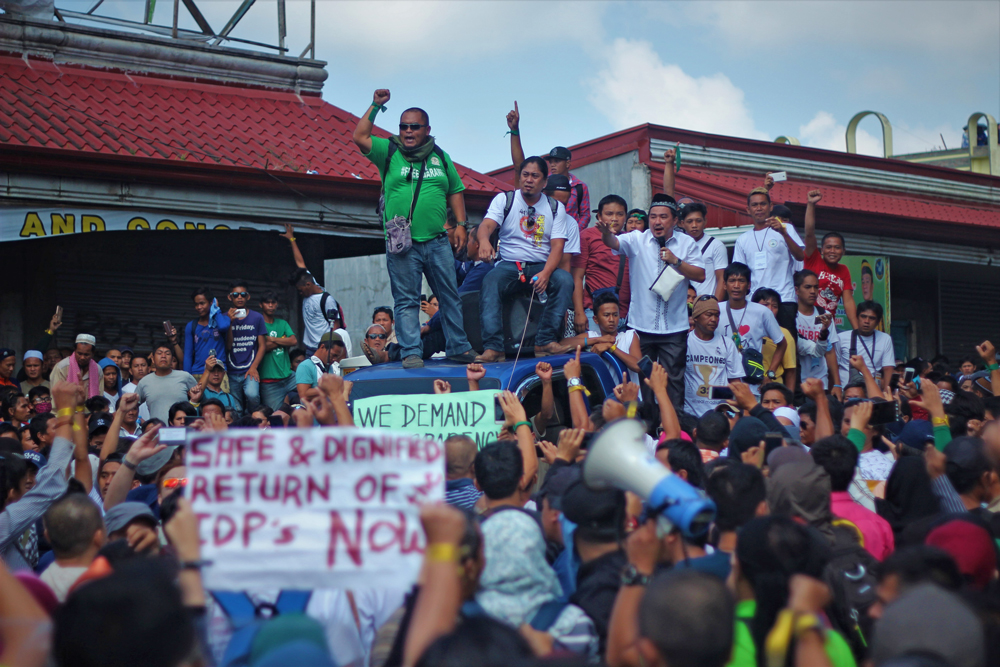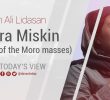Ever heard of that song by Dionne Warwick and later revived by Luther Vandros – A House is not a Home? That is how I can describe what the Meranaw people feel about the rehabilitation efforts of President Rodrigo Duterte and the Task Force Bangon Marawi to Marawi City.
In a press conference on April 12, almost two weeks after their their protest march in Marawi City, the Ranaw Multi-Sectoral Movement demanded from President Rodrigo Duterte to allow the residents to be part of the rehabilitation, planning, decision-making, and assessment of the “ground zero areas,” the 24 barangays severely affected by the fight between the Armed Forces of the Philippines (AFP) and the Maute Brothers and ISIS-inspired groups last year and to this day remained off limits to civilians.
Theirs is but a justified demand – the government is planning about their homes, their communities, their properties, their life. Our Meranaw brothers and sisters were forcibly displaced on May 23 last year because of the siege of ISIS-inspired groups and five months of military airstrikes levelled off the area leaving rubbles, mosques and houses riddled with bullets and destroyed by bombs. Ten months after, ground zero residents were allowed to visit their houses, only to find out that their houses were looted by the military, some during the fighting, others at the time that they were assigned to secure the areas.
The aim of the Ranaw Multi-Sectoral Movement protest march on March 30 was to go inside the most affected areas (MAA) not only to visit but to permanently stay. They called it “kambalingan,” as opposed to the “kambisita” campaign by the TFBM that allowed the residents to visit by different batches the MAA on April 1-May 10. In Meranaw dialect, kambalingan means to go back to your home and community whereas kambisita means merely to visit. Kambalingan had a purpose of the residents rebuilding their own community, with or without government paying for the damage to support the rebuilding of their houses, a statement to “reclaim” their community from the government-sponsored rehabilitation plans.
The youth group League of Filipino Students (LFS) in Marawi City slammed the kambisita program, saying they were insulted that after 10 months of being away from their homes, all they were allowed to do was to look at their homes, have an initial assessment of the damage of their houses, salvage what was left of their properties and immediately ushered out of the area by the military. The survivors group Tindeg Ranao slammed the military for double standards – they stopped the residents from going inside the MAA but allowed actors inside, and like tourists take selfies with their destroyed houses and building as the background.

Thousands of Meranaw residents in Marawi City stage a symbolic protest to condemn the slow-paced government rehabilitation of their homes ravaged by war on Friday, March 30, 2018. (Kath M. Cortez/davaotoday.com)
The protest march had a strong message of refusing rehabilitation plans by TFBM and President Duterte that included a military camp and an economic zone for the 250-hectare MAA. In their statement last March 29, they criticized the “urban architects and master planners” from the TFBM who laid out the blueprint in public on March 21-22 for not reflecting their history, their culture and the identity of the “lakeside” people, the meaning of the Meranaw ethnic group.
The Bangon Marawi Comprehensive Rehabilitation and Recovery Program (BMCRRP) blueprint that National Development Authority (NEDA) presented to the public included livelihood, business deployment and land resource management as among the key priority programs and another 860 projects for livelihood and business sectors will be implemented from 2018 to 2022.
President Rodrigo Duterte continue to blame them for allowing the siege to happen last year and even underestimate the Meranaw people’s capacity to rebuild their community. Before he left for China on April 11, he reacted to the demands of the Meranaw residents saying that they should not meddle with the rehabilitation efforts, to leave the plan to the government since the Meranaws have no money and no plans for rebuilding.
But with the World Bank (WB) and International Monetary Fund (IMF) as the lead lending agencies that will fund the rehabilitation of Marawi City and provide the technical advise and expertise for reconstruction, the Filipino people not only the Meranaw should really be afraid. The reconstruction of the Islamic City of Marawi becomes another government-sponsored land grabbing and wholesale selling of ancestral lands of the Moro people.
Last December 2017, the Department of Finance (DOF) announced that they have plans of turning the Islamic City of Marawi into a “community-based economic zone” envisioned to be a center for marketing, technical training, and food processing ventures for micro, small and medium enterprises (MSMEs).
Like President Duterte’s Build Build Build project, private investors were also tapped to invest in the government’s rehabilitation of Marawi City. Maynilad Water and Manila Water will invest for the city’s water system, Philippine Business for Social Progress (PBSP) chair Manuel V. Pangilinan and MPIC executives for the power and water system, Ayala Foundation will build a hospital. Other private companies include Udenna Corp, Aboitiz Group, Jollibee Foods Corp, Pepsi Cola Philippines, FF Cruz, Meralco, Coca Cola, World Vision, Oxfam, Cebuana Lhuillier, San Miguel Foundation, SM Foundation and LBC Foundation.
On January 30, President Duterte announced that a 10-hectare regiment-size military camp worth P400 million will be built inside the MAA. Marawi City already has a military camp near the provincial capitol where the 103rd Infantry Brigade of the Philippine Army is stationed as well as a number of undetermined US soldiers.
When we heard US President Donald Trump’s description of the Philippines as a “most prime piece of real estate from a military standpoint” during his visit last year in the Philippines for the ASEAN meet, we cannot dismiss the idea that the government intends to make Marawi City a base for US soldiers and their war materiel. The participation of the US government in providing intelligence, soldiers, and drones during the Marawi Crisis helped in helming the latest anti-terror strategy, the Operation Plan Pacific Eagle.
I cringe at the idea of turning Marawi city into a tourist hub, as previously proposed by President Duterte and renowned architect and urban planner Felino “Jun” Palafox Jr. Palafox wanted to preserve the ruined areas of Marawi City as a “museum of terrorism.” How can the Meranaws accept a rehabilitation plan that was meant to exploit their history, culture and the trauma they experienced during the siege and turn them into a freakshow.

The area in Lower Dansalan, Marawi City near the lake after President Rodrigo Duterte declared Marawi City liberated from terrorists’ influence last October 17, 2017. (Divina M. Suson / davaotoday.com)
We should also be critical of the funds that President Duterte and TFBM have been harvesting for the rehabilitation of Marawi City, as it comes with strings. Already, he boasted China’s grant of 500 million yuan (US$79.5 million) for the rehabilitation of Marawi City when he visited Hongkong last week. Earlier, the US government thru the US Agency for International Development (USAID) has already given more than $20.9 million (P1 billion) assistance to the rebuilding of Marawi City. Defense Secretary Delfin Lorenzana also announced last year that foreign aid had already reached P2.1 billion from Australia, Japan, Thailand, the European Union, US and China.
There are basis to the Meranaw people’s fear of losing their beloved Islamic City. I remember how the Moro people lost Camp Abubakar during President Joseph Estrada’s all-out war against the Moro Islamic Liberation Front (MILF) in July 2000. The war resulted in the displacement of more than 100,000 Moro people, destroyed communities, properties and farmlands.
Camp Abubakar was an attempt of the MILF’s former chair and martyr Ustadz Hashim Salamat to provide a settlement for the displaced Moro people who were victims of landgrabbing and who fled military operations in their communities. Ustadz Salamat was able to gather in one community most of the Moro’s 13 ethnolinguistic groups. It was then called Camp Abubakar, the major and central MILF camp in the mountains of three adjacent municipalities in the first district of Maguindanao – Matanog, Barira and Buldon.
It is a construct community, unlike the ancestral homes of the Meranaws in Marawi City, and yet the people who lived there defended the community and made it their own. The community was aimed to stop the diasphora of the Moro people due to government’s programs that forcibly took Moro farmlands, sold them to foreign and loca investors and converted them into monocrop agricultural plantations and resettlement of farmers from outside of Mindanao.
I was there when the first bombs fell in Camp Abubakar. I was visiting my grandmother in our ancestral home in Matanog when then President Joseph Estrada decided to forgo the on-going peace process in Cotabato City and declared an all-out war against the MILF. The MILF was protrayed as a terrorist organization and Camp Abubakar as the haven of terrorists. This was even before 9-11, before US President George Bush divided the world and initiated the US global war on terror.
The residents of Camp Abubakar were not allowed to return after the war, in its place a military camp was established. From the fall of Camp Abubakar in 2000, the Philippine Army’s 603rd Infantry Brigade garrisoned the area, renamed it to Camp Iranun and served as its headquarters untill June 2015. The Philippine Army’s 37th Infantry Battalion took over after.
While the government and the MILF is still in the process of identifying which resources should be divided for the Bangsamoro and the national government, the local government of the Moro people is already selling Moro lands, including the MILF’s former Camp Abubakar.
In 2015, Regional Board of Investments of the Autonomous Region in Muslim Mindanao (RBOI-ARMM) administered the P3.7B investment of UNIFRUTTI Group of Companies for cavendish banana plantation to be set up in the Barira and Buldon part of Camp Abubakar. The cavendish banana plantation is part of the Mindanao Rural Development Program of the Department of Agriculture bankrolled by World Bank to which Unifrutti has partnered with.
In 2013, ARMM also allowed the nickel-ore mining operation in Tumabagaan Island in Languyan, one of the big land mass in the island of Tawi-Tawi to Chinese investors in cooperation with local companies. Through the WB and the Japan International Cooperation Agency (Jica), local private sectors also promised to invest $366 million (P16.3 billion) to develop conflict areas, despite of the delays in the signing of the final agreement between the government and the MILF or the passage of the Bangsamoro Basic Law (BBL). Investors included the Philippine Long Distance Telephone Co. chair Manuel V. Pangilinan and Ayala Corporation chair and CEO Jaime Augusto Zobel de Ayala as well as San Miguel Corporation for agricultural plantations.
It is cruel for the government to deprive the people of their homes, and then profit from their misery, the devastation of their community and the death of their people. The most that the residents got right now from the multibillion dollar rehabilatation program are the temporary shelters that are miles away from the lake, lacking of water supplies and other basic services. As the government continue to leave them out of the drawing board, they will eventually lose their home in place of investors, business ventures and “development” programs. The Islamic City of Marawi loses its soul, it’s identity as the home of the people of the lake. (davaotoday.com)






